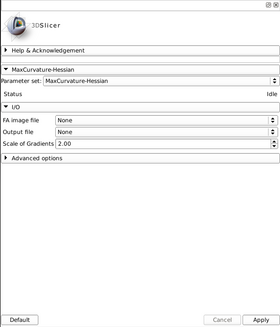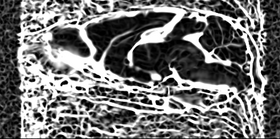Documentation/4.2/Modules/maxcurvature
From Slicer Wiki
Revision as of 22:37, 27 November 2012 by Fbudin (talk | contribs) (Created page with ' __NOTOC__ ===MaxCurvature-Hessian=== MaxCurvature-Hessian {| |thumb|280px|User Interface |[[Image:MaxCurvatureResults.png|thumb|280px|Output compute…')
Home < Documentation < 4.2 < Modules < maxcurvature
MaxCurvature-Hessian
MaxCurvature-Hessian
General Information
Module Type & Category
Type: CLI
Category: Diffusion.NIRALPipeline
Authors, Collaborators & Contact
Author: Casey Goodlett
Contributors:
Contact: name, email
Module Description
| Program title | MaxCurvature-Hessian |
| Program description | This program computes the Hessian of the FA image (--image). We use this scalar image as a registration input when doing DTI atlas building. For most adult FA we use a sigma of 2 whereas for neonate or primate images and sigma of 1 or 1.5 is more appropriate. For really noisy images, 2.5 - 4 can be considered. The final image (--output) shows the main feature of the input image. |
| Program version | 1.1.0 |
| Program documentation-url | http://www.google.com/ |
Usage
Quick Tour of Features and Use
A list panels in the interface, their features, what they mean, and how to use them.
|
More Information
More information is available on the project webpage: http://www.nitrc.org/projects/dtiprocess
Acknowledgment
Hans Johnson(1,3,4); Kent Williams(1); (1=University of Iowa Department of Psychiatry, 3=University of Iowa Department of Biomedical Engineering, 4=University of Iowa Department of Electrical and Computer Engineering) provided conversions to make DTIProcess compatible with Slicer execution, and simplified the stand-alone build requirements by removing the dependancies on boost and a fortran compiler.

